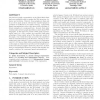Free Online Productivity Tools
i2Speak
i2Symbol
i2OCR
iTex2Img
iWeb2Print
iWeb2Shot
i2Type
iPdf2Split
iPdf2Merge
i2Bopomofo
i2Arabic
i2Style
i2Image
i2PDF
iLatex2Rtf
Sci2ools
SPIRE
2009
Springer
2009
Springer
k2-Trees for Compact Web Graph Representation
The directed graph representation of the World Wide Web has been extensively used to analyze the Web structure, behavior and evolution. However, those graphs are huge and do not fit in main memory, whereas the required graph algorithms are inefficient in secondary memory. Compressed graph representations reduce their space while allowing efficient navigation in compressed form. As such, they allow running main-memory graph algorithms on much larger Web subgraphs. In this paper we present a Web graph representation based on a very compact tree structure that takes advantage of large empty areas of the adjacency matrix of the graph. Our results show that our method is competitive with the best alternatives in the literature, offering an interesting space/time tradeoff. It gives a very good compression ratio (3.3–5.3 bits per link) while permitting fast navigation on the graph to obtain direct as well as reverse neighbors (2– 15 microseconds per neighbor delivered). Moreover, we ...
Directed Graph Representation | Graph Algorithms | Graph Representations | Information Retrieval | SPIRE 2009 |
| Added | 27 May 2010 |
| Updated | 27 May 2010 |
| Type | Conference |
| Year | 2009 |
| Where | SPIRE |
| Authors | Nieves R. Brisaboa, Susana Ladra, Gonzalo Navarro |
Comments (0)

